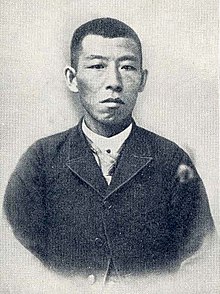Inō Kanori
Inō Kanori | |
|---|---|
 | |
| Born | June 11, 1863 |
| Died | September 30, 1925 (aged 62) |
| Occupation | anthropologist |
Template:Japanese name Inō Kanori (伊能 嘉矩, 11 June 1867 – 30 September 1925), was a Japanese anthropologist and folklorist known for his studies in Taiwanese Aborigines. Ino was the first person who classified the aboriginal tribes into several groups, instead of the traditional classification which imprecisely recognized these aborigines only as "cooked/domesticated" (熟蕃, jukuban) or "raw/wild" (生蕃, seiban).
Biography
Inō was born in what is now part of the city of Tōno, Iwate, Japan. He moved to Tokyo in 1885 and was active in the Freedom and People's Rights Movement. He later worked as a journalist and for a printing company before becoming a pupil of the noted professor of Biological anthropology, Tsuboi Shogoro at Tokyo Imperial University in 1893, along with Torii Ryūzō. Following the acquisition of Taiwan by the Empire of Japan following the First Sino-Japanese War in 1895, he received permission from the Governor-General of Taiwan to conduct research there. He remained in Taiwan to 1906, publishing several works on the culture of the Taiwanese aborigines.
In The Island of Formosa (1903), former US Consul to Formosa James W. Davidson presented the first English-language account of the aborigines of the whole island, which was almost entirely based on the comprehensive work collected over several years of study by Ino, the foremost authority on the topic at the time.[1] In his book, Davidson presented Ino's formalization of eight tribes of Taiwanese aborigines: Atayal, Vonum, Tsou, Tsalisen, Paiwan, Puyuma, Ami and Pepo.
Inō returned to his native Tōno in 1905 and pursued cultural and folklore studies there, together with Kizen Sasaki. He became acquainted with Kunio Yanagita, who was also collecting the oral traditions and tales in preparation of his Tōno Monogatari. He died in 1925, due to complication from malaria contracted while he was living in Taiwan.
Bibliography
- Kanori Ino (2012). 平埔族調查旅行: 伊能嘉矩<台灣通信>選集 [Research trips among the Plains Aborigines: Selections from Inō Kanori's Taiwan diaries] (in Chinese). Translated by Yang Nanjun [in Chinese]. Taipei: Yuan-Liou. ISBN 9789573268932.
See also
References
- ^ Davidson, James W. (1903). "Chapter XXX: The Inhabitants of Formosa". The Island of Formosa, Past and Present : history, people, resources, and commercial prospects : tea, camphor, sugar, gold, coal, sulphur, economical plants, and other productions. London and New York: Macmillan. p. 561. OCLC 1887893. OL 6931635MNote: Credited as "Y. Ino".
{{cite book}}: Invalid|ref=harv(help)CS1 maint: postscript (link)
